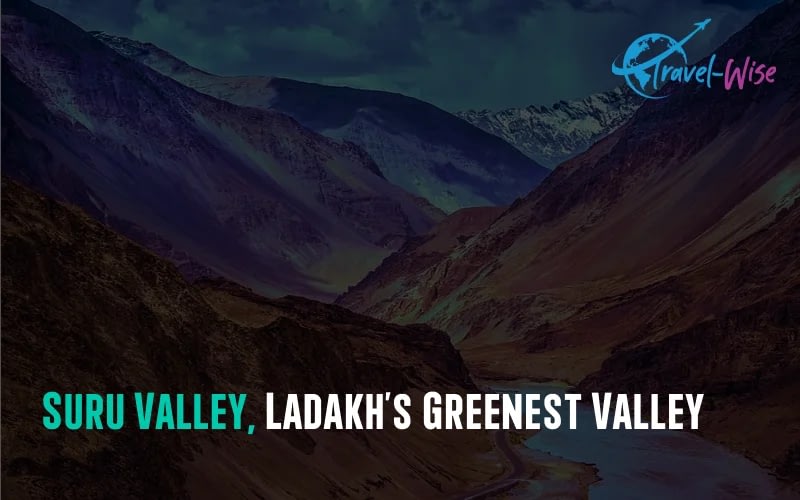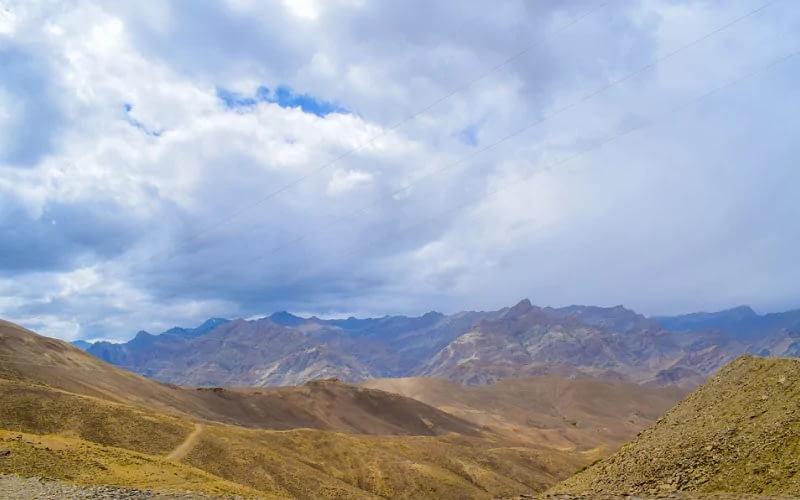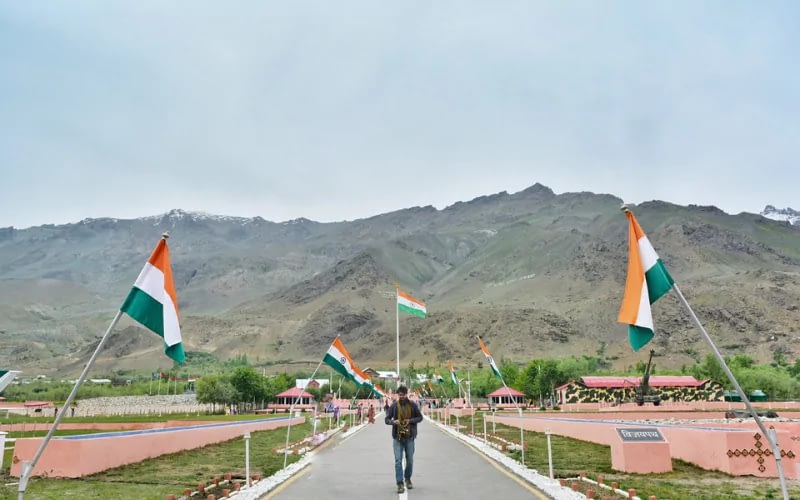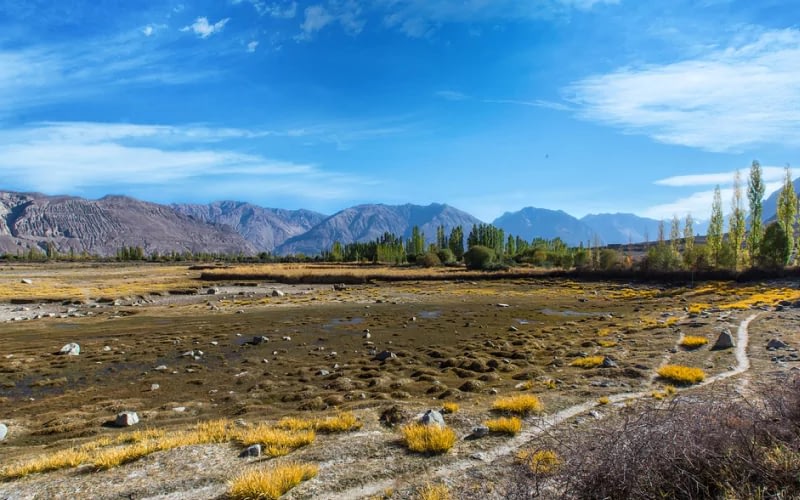Imagine a lush green valley hidden in the rocky Himalayan peaks of Ladakh. Vibrant meadows bloom with a mix of wildflowers. Crystal-clear lakes weave through the landscape. This is Suru Valley. It is India’s hidden paradise. It will leave you amazed with its beauty and calm.
Featured Image Credit
It is often called the “Valley of Flowers.” The Suru Valley is a refreshing oasis. It contrasts with the dry and barren vistas that Ladakh is known for. As you go into this scenic wonderland, you’ll see picture-perfect vistas. They have snow-capped mountains, lush meadows, and traditional villages. In those villages, time seems to stand still.
But Suru Valley isn’t just beautiful. It’s a cultural melting pot. Buddhist, Muslim, and Hindu communities live in harmony there. Each adds its own unique flavor to the region’s rich heritage. From old monasteries to lively festivals, there’s a charm that will grab you. It’s authentic.
The Suru Valley promises an unforgettable journey. It has stunning landscapes and friendly communities. You can disconnect from the modern world. It’s perfect for nature lovers, adventure seekers, and cultural explorers. Get ready to head on a dream-like adventure in this green paradise of Ladakh.
Journey to Suru Valley
Starting on a journey to the Suru Valley is an adventure in itself. It is deep within the Himalayas of Ladakh. Getting to this hidden paradise takes some planning and preparation. Here’s how you can make your way to this beautiful valley:
How to reach Suru Valley
- By Air: The nearest airport is Leh’s Kushok Bakula Rimpochee Airport. It has flights to major Indian cities like Delhi, Mumbai, and Srinagar. From Leh, you can hire a taxi or take a shared cab to Kargil, the gateway to Suru Valley.
- By Road: If you’re an adventurous soul, you can embark on a scenic road trip from Srinagar or Manali to Kargil. The journey itself is an experience. Breathtaking vistas of the Himalayas come with you along the way.
The best modes of transportation
- Private Taxis or Shared Cabs: These are the most convenient options. This is especially true if you’re traveling in a group or with family. You can hire a taxi or join a shared cab from Leh or Kargil to explore Suru Valley at your own pace.
- Public Transport: For budget travelers, there are state-run buses between Kargil and Suru Valley villages. But the schedules may be limited.
- Self-Drive: Renting a car or motorcycle can be thrilling. It’s a great way to navigate the winding roads and remote villages of Suru Valley. But be ready for tough terrain and altitude sickness.
Ideal starting points:
- Kargil: It is the main gateway to Suru Valley. It’s a great place to stock up on supplies. You can also arrange transport. You can get used to the altitude before going further into the valley.
- Panikhar: Panikhar is the place to start if you’re short on time. It is a pretty village at the entrance of Suru Valley. The village is known for its apricot orchards and old stone houses.
No matter how you choose to reach Suru Valley, the journey is part of the experience. It offers stunning views and a taste of the region’s rugged charm. So, buckle up. Get ready for an unforgettable adventure!
Exploring Suru Valley
Once you’ve started your journey to Suru Valley, a world of nature and culture awaits you. This lush paradise has many key attractions. They will leave you spellbound. Here’s a glimpse of what you can explore:
Hidden Gems and Offbeat Places
The Suru Valley is known for its iconic destinations. But the region’s true beauty is in its hidden gems and offbeat places. These lesser-known spots offer a unique and real experience. They let you step off the beaten path and spend time in the local culture and untouched nature.
- Kartse Khar
This remote village is a true hidden gem, tucked away in the heart of the Suru Valley. Kartse Khar is home to the region’s last Buddhist nunnery. There, you can see the old traditions and way of life of the nuns. The village also offers stunning views of the surrounding peaks and glaciers.
- Umba Village
Umba Village is located in lush green meadows and apricot orchards. It is an offbeat destination that has rustic charm. Here, you can see the traditional Dard culture. You can also explore ancient rock carvings. You can even try traditional farming techniques with the friendly locals.
- Pensi La
The trek is for adventure seekers. It offers a thrilling challenge. This high-altitude pass is at an elevation of 4,400 meters. The trek rewards hikers with stunning views of the Nun-Kun Massif. It also offers the chance to see the nomadic Himalayan lifestyle up close.
- Suru River Rafting
Suru River Rafting offers an adrenaline-pumping adventure. You will raft down the pure waters of the Suru River. This offbeat activity offers a unique view of the valley’s stunning landscapes. You navigate through rapids and calm stretches. The peaks and meadows tower and glow around you.
- Dras Valley
Dras Valley is not technically part of Suru Valley. But it is a nearby, offbeat destination that shouldn’t be missed. It’s known as the “Gateway to Ladakh.” The remote valley gives a glimpse into the rugged beauty of the region. You can trek, camp, and see the unique Dard culture there.
Exploring these hidden gems and offbeat places means going off the beaten path. It will satisfy your thirst for adventure. They will also give you a deeper understanding and appreciation of Suru Valley. It has a rich culture and natural beauty.
Trekking Trails and Adventure Activities
It offers many trekking trails and outdoor activities. They are for those seeking adventure or a chance to experience Suru Valley’s beauty. They cater to all levels of experience and thrill.
- Nun-Kun Massif Trek
The Nun-Kun Massif Trek is very hard. But it is also very rewarding. It is in the Himalayas. It takes you through breathtaking landscapes, glaciers, and high passes. The trek lasts many days. It is a true test of endurance. It offers unmatched views of the majestic Nun and Kun peaks.
- Rangdum Monastery Trek
The Rangdum Monastery Trek is shorter but equally scenic. It’s a great option if you’re looking for a shorter trek. This easy trail goes through lush meadows and old villages. It ends at the ancient Rangdum Monastery. From there, you can see the stunning glaciers and peaks.
- Rock Climbing
The valley’s rugged terrain has towering cliffs. It is an ideal destination for rock climbing fans. The region offers easy routes for beginners. It also has hard multi-pitch climbs. Both seasoned climbers and those trying the sport can find options there.
- River Rafting
Feel the thrill of navigating the rapids of the Suru River or the nearby Indus River. Do it through a rafting adventure. This exhilarating activity combines the rush of whitewater rafting with beautiful mountain views. It creates an unforgettable experience.
- Mountain Biking
Explore Suru Valley’s winding trails on a mountain bike. They wind through remote villages. Mountain biking is a great way to see the region’s diverse landscapes. You go from lush meadows to rocky paths. It also provides an adrenaline rush.
- Camping and Stargazing
Suru Valley has clear skies and a pristine environment. It is ideal for camping and stargazing. Spend a night under the starry Himalayan sky. It’s surrounded by a serene valley. There, you can see the magical Milky Way in all its glory.
It offers many trekking trails and activities. They are for both experienced trekkers and beginners seeking thrills. They cater to all levels of enthusiasm and expertise. Take on the challenge. Soak in the stunning view. Make memories that will last a lifetime.
Cultural Immersion
Suru Valley has pretty landscapes and adventure. It also has a rich tapestry of culture. They let you in on the local way of life, traditions, and culinary delights.
Local communities and their way of life
- The Dard people are the main ethnic group in Suru Valley. They have kept their unique culture and way of life for centuries. Explore their old villages. Time seems to have stood still. See their ancient practices, like complex wood carving and weaving.
- Interact with the warm locals. They will gladly welcome you into their homes. They will share stories about their rich heritage and customs.
- See the peaceful coexistence of diverse religious communities. They include Buddhists, Muslims, and Hindus. They have lived together in the Suru Valley for generations, creating a unique culture.
Traditional festivals and events
- Attend the vibrant Parkachik Festival. It celebrates the region’s diverse traditions. See colorful folk dances and music. Feel the festive atmosphere that unites the whole valley.
- The Dard community celebrates the Gustor Festival. It is a fascinating event where locals play polo and do archery. They also do traditional sports. The festival offers a glimpse into their rich culture.
- Buddhist festivals, such as Losar and the Sindhu Darshan Festival, are colorful. People celebrate them with prayer ceremonies, mask dances, and cultural performances. They happen at the region’s ancient monasteries.
Cuisine and culinary delights
- Enjoy the flavors of Suru Valley’s unique cuisine. It is a delightful mix of Tibetan, Kashmiri, and Central Asian influences.
- Try local delicacies. They include skyu, a traditional pasta. Also, there’s chhurpee, a bread made with apricot oil, and the famous Ladakhi apricot jam.
- Sip the traditional butter tea. It’s a staple beverage in the region. Experience the warm hospitality of the locals. They welcome you with this comforting drink.
The Best Time to Visit Suru Valley
The ideal time to visit Suru Valley depends on your preferences and interests. Summer is from June to September. It offers the best weather for outdoor activities. The shoulder seasons and winter are perfect for cultural experiences.
Summer (June–September)
- Pleasant temperatures (15°C – 25°C), ideal for trekking and camping
- Witness the stunning “Valley of Flowers” in full bloom.
- Clear skies for unobstructed views of the Himalayan peaks
Cultural Festivals
- August: Attend the vibrant Parkachik Festival, celebrating the region’s diversity.
- February/March: Witness Buddhist festivals like Losar (Tibetan New Year) and Sindhu Darshan.
No matter when you visit, Suru Valley promises a unique experience. It blends beauty and culture into an unforgettable journey.
Tips for Responsible Travel
Exploring the stunning Suru Valley is not only about its beauty and culture. It’s also about making sure your journey helps the region and its people. Responsible travel is key to saving the valley’s delicate ecosystem. It is also key to respecting the local communities. Here are some essential tips to keep in mind:
Respecting local cultures and customs
- The Suru Valley is home to many cultures and religions. Each has its own traditions and customs. Respect these practices. This is crucial when visiting sacred sites like monasteries or attending festivals.
- Dress modestly and seek permission before photographing locals or entering religious places.
- Learn a few basic phrases in the local languages. They are Dardi, Ladakhi, or Urdu. Use them to talk to the residents and show you appreciate their culture.
Sustainable tourism practices
- Choose eco-friendly accommodations. These can be homestays or campsites. They support local communities and have minimal environmental impact.
- Reduce your plastic waste. Do this by carrying reusable water bottles and saying no to single-use plastics.
- Practice responsible trekking. Stick to the designated trails. Properly dispose of waste. Minimize your carbon footprint.
- Support local businesses. Buy locally made handicrafts, food, and services. This helps the region’s economy last.
Safety precautions and essentials
- Suru Valley’s high altitude and rugged terrain can pose challenges for travelers. Acclimate well. Drink plenty of fluids. Be mindful of signs of altitude sickness.
- Pack the right gear. This includes sturdy hiking boots, warm clothes, and medical supplies.
- Hire local guides or join tours. This is especially important for tough treks or remote areas. Guides have invaluable knowledge of the land and can keep you safe.
- Stay informed about the weather and risks, like avalanches or landslides. Plan your trip accordingly.
Conclusion
The Suru Valley is a true hidden gem, a lush paradise situated among the rocky Himalayas of Ladakh. The valley has stunning landscapes. It also has a rich cultural tapestry and plenty of adventure opportunities. It promises an unforgettable journey. You may find comfort in nature. You may also seek thrilling outdoor pursuits or an unforgettable cultural experience. Suru Valley has something to offer every traveler. So, pack your bags. Take on the spirit of exploration. It will leave you fascinated and wanting more.
At Travel-Wise, we understand that planning a great trip can be tough. This is especially true when exploring far-off places like the Suru Valley. That’s why we’ve developed a powerful trip planning tool to make your adventure smooth. You can use our easy-to-use trip planner app to make custom itineraries. You can also find trusted local guides and get useful resources. They will help ensure a safe and fun trip. Learn more about Travel-Wise features and start with our trip planner app. We will help you find the secrets of this hidden paradise and make memories that will last a lifetime.
Start planning your trip now with Travel-Wise’s free trip-planning tools to have you on your way to your destination faster than ever!




